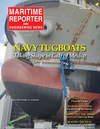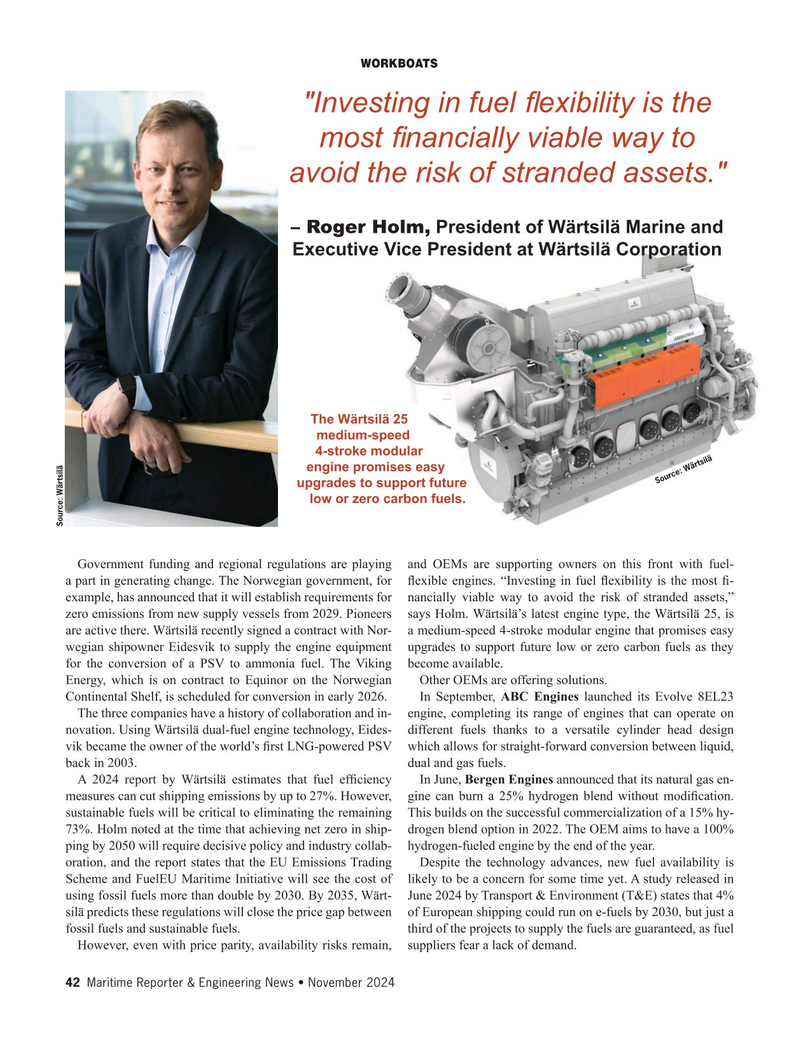
Page 42: of Maritime Reporter Magazine (November 2024)
Read this page in Pdf, Flash or Html5 edition of November 2024 Maritime Reporter Magazine
WORKBOATS "Investing in fuel ? exibility is the most ? nancially viable way to avoid the risk of stranded assets." – Roger Holm, President of Wärtsilä Marine and
Executive Vice President at Wärtsilä Corporation
The Wärtsilä 25 medium-speed 4-stroke modular engine promises easy
Source: Wärtsilä upgrades to support future low or zero carbon fuels.
Source: Wärtsilä
Government funding and regional regulations are playing and OEMs are supporting owners on this front with fuel- a part in generating change. The Norwegian government, for ? exible engines. “Investing in fuel ? exibility is the most ? - example, has announced that it will establish requirements for nancially viable way to avoid the risk of stranded assets,” zero emissions from new supply vessels from 2029. Pioneers says Holm. Wärtsilä’s latest engine type, the Wärtsilä 25, is are active there. Wärtsilä recently signed a contract with Nor- a medium-speed 4-stroke modular engine that promises easy wegian shipowner Eidesvik to supply the engine equipment upgrades to support future low or zero carbon fuels as they for the conversion of a PSV to ammonia fuel. The Viking become available.
Energy, which is on contract to Equinor on the Norwegian Other OEMs are offering solutions.
Continental Shelf, is scheduled for conversion in early 2026. In September, ABC Engines launched its Evolve 8EL23
The three companies have a history of collaboration and in- engine, completing its range of engines that can operate on novation. Using Wärtsilä dual-fuel engine technology, Eides- different fuels thanks to a versatile cylinder head design vik became the owner of the world’s ? rst LNG-powered PSV which allows for straight-forward conversion between liquid, back in 2003. dual and gas fuels.
A 2024 report by Wärtsilä estimates that fuel ef? ciency In June, Bergen Engines announced that its natural gas en- measures can cut shipping emissions by up to 27%. However, gine can burn a 25% hydrogen blend without modi? cation. sustainable fuels will be critical to eliminating the remaining This builds on the successful commercialization of a 15% hy- 73%. Holm noted at the time that achieving net zero in ship- drogen blend option in 2022. The OEM aims to have a 100% ping by 2050 will require decisive policy and industry collab- hydrogen-fueled engine by the end of the year.
oration, and the report states that the EU Emissions Trading Despite the technology advances, new fuel availability is
Scheme and FuelEU Maritime Initiative will see the cost of likely to be a concern for some time yet. A study released in using fossil fuels more than double by 2030. By 2035, Wärt- June 2024 by Transport & Environment (T&E) states that 4% silä predicts these regulations will close the price gap between of European shipping could run on e-fuels by 2030, but just a fossil fuels and sustainable fuels. third of the projects to supply the fuels are guaranteed, as fuel
However, even with price parity, availability risks remain, suppliers fear a lack of demand.
42 Maritime Reporter & Engineering News • November 2024
MR #11 (34-49).indd 42 10/23/2024 5:05:18 PM

 41
41

 43
43
